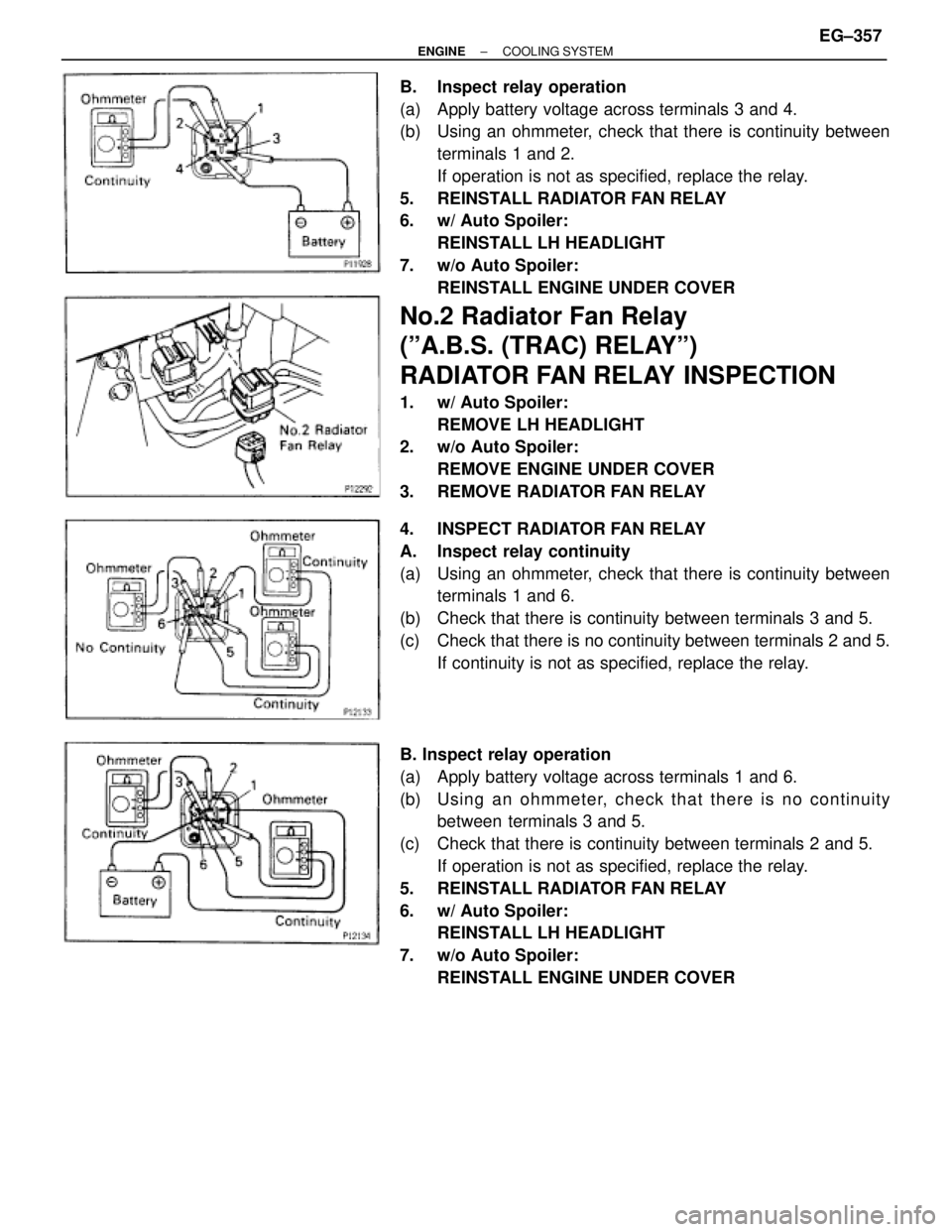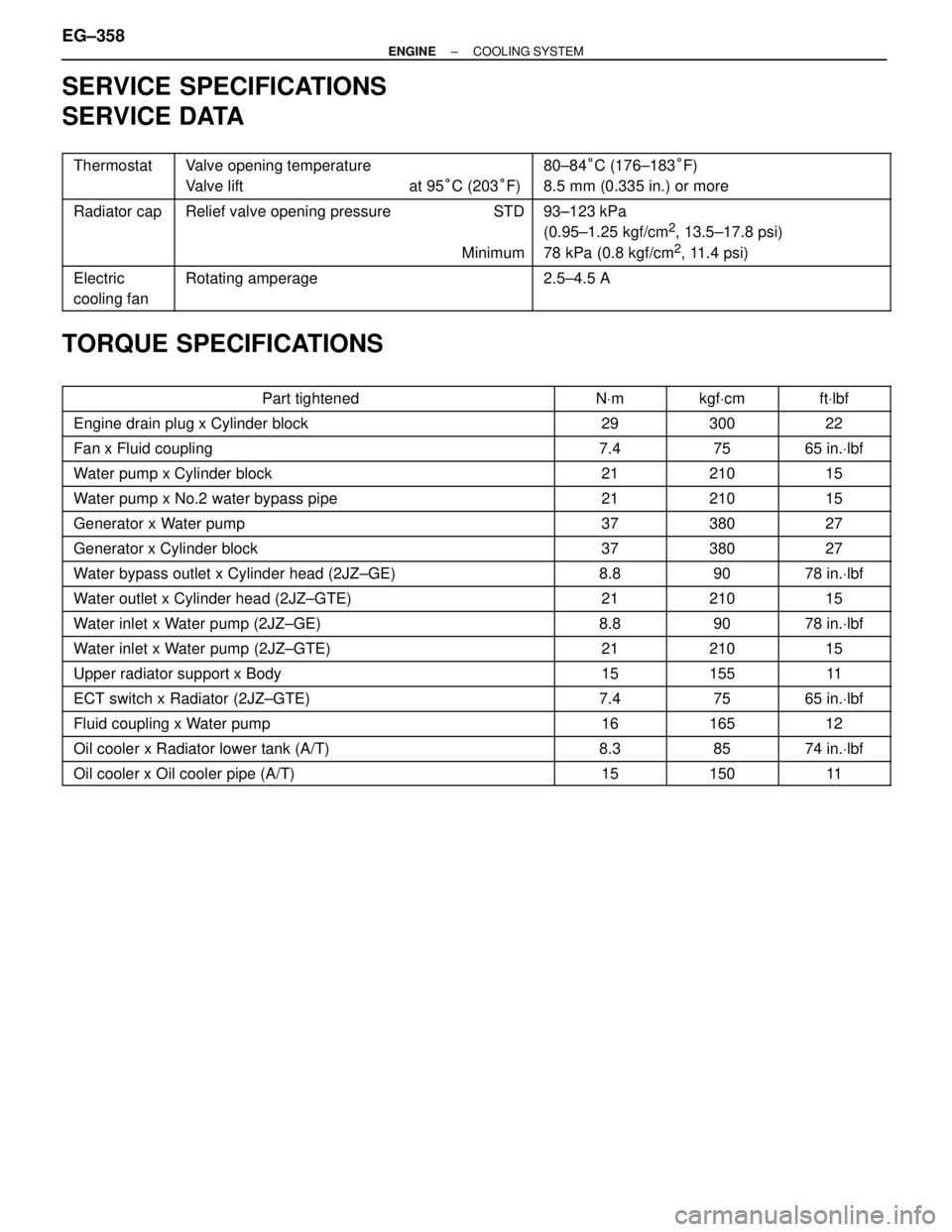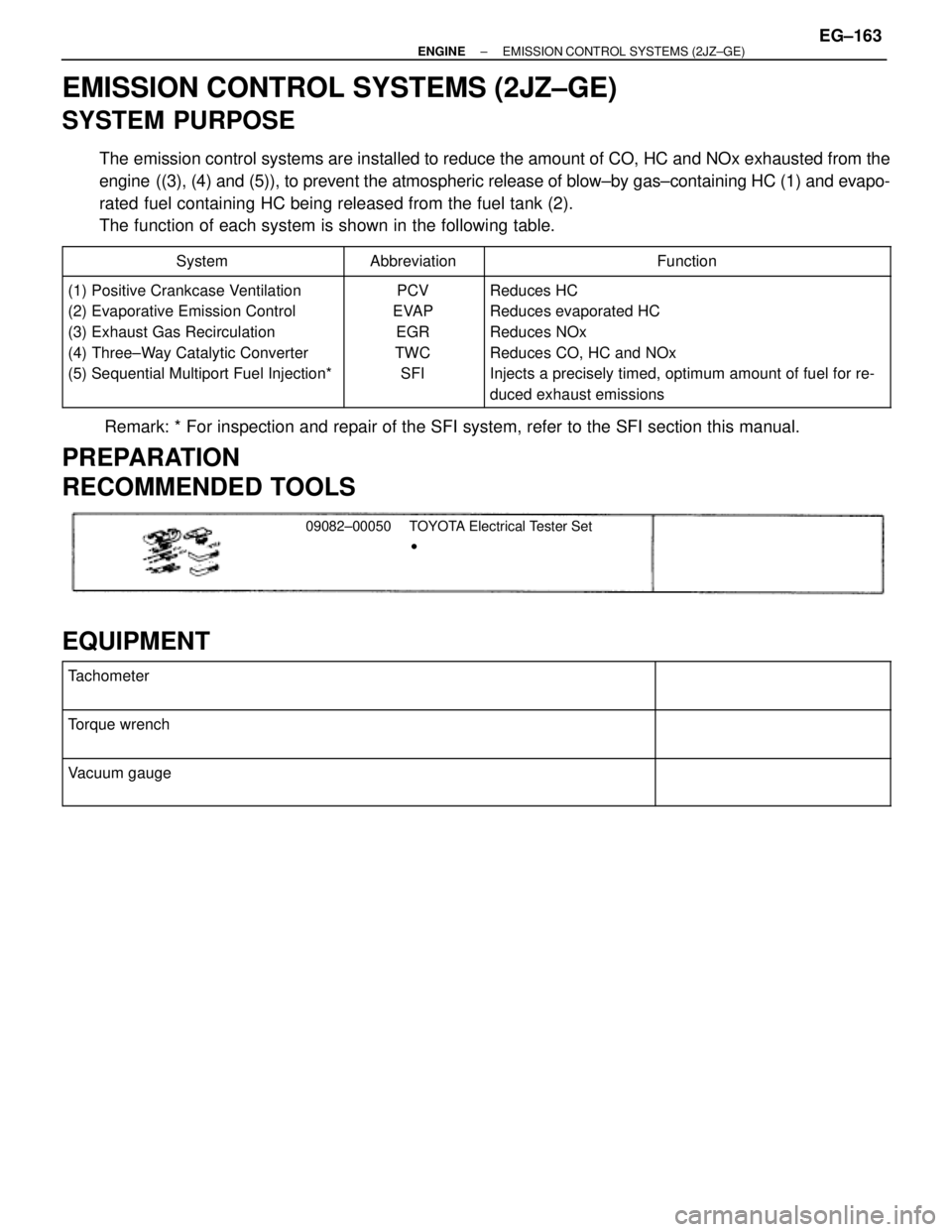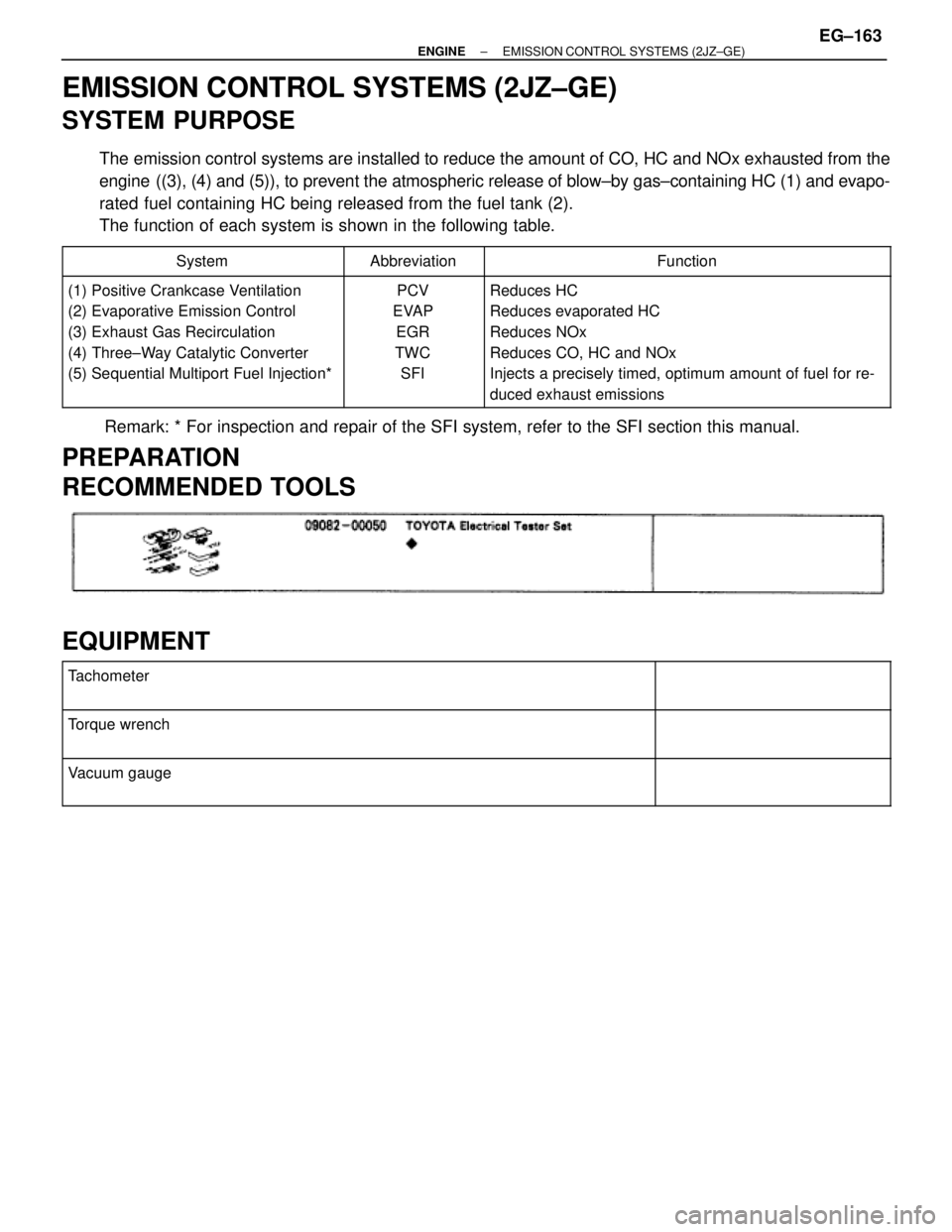Page 1107 of 2543

Engine Coolant Temperature (ECT)
Switch
ECT SWITCH INSPECTION
1. REMOVE ENGINE UNDER COVER
2. DRAIN ENGINE COOLANT
3. REMOVE ECT SWITCH
(a) Disconnect the ECT switch connector.
(b) Remove the ECT switch.
(c) Remove the O±ring from the ECT switch.
4. INSPECT ECT SWITCH
(a) Usin g an oh mme te r, ch e ck th a t th e re is no co n tin u ity
between the terminals when the coolant temperature is
above 97°C (207°F).
(b) Using an ohmmeter, check that there is continuity between
the terminals when the coolant temperature is below 88°C
(190°F).
If continuity is not as specified, replace the switch.
5. REINSTALL ECT SWITCH
(a) Install a new O±ring to the ECT switch.
(b) Apply soapy water to the O±ring.
(c) Install the ECT switch.
Torque: 7.4 NVm (75 kgfVcm, 65 in.Vlbf)
(d) Connect the ECT switch connector.
6. REFILL WITH ENGINE COOLANT
7. START ENGINE AND CHECK FOR LEAKS
8. REINSTALL ENGINE UNDER COVER
No.1 Radiator Fan Relay
(ºRADIATOR FAN RELAYº)
RADIATOR FAN RELAY INSPECTION
1. w/ Auto Spoiler:
REMOVE LH HEADLIGHT
2. w/o Auto Spoiler:
REMOVE ENGINE UNDER COVER
3. REMOVE RADIATOR FAN RELAY
4. INSPECT RADIATOR FAN RELAY
A. Inspect relay continuity
(a) Using an ohmmeter, check that there is continuity between
terminals 3 and 4.
(b) Check that there is no continuity between terminals 1 and 2.
If continuity is as specified, replace the relay. EG±356
± ENGINECOOLING SYSTEM
Page 1108 of 2543

B. Inspect relay operation
(a) Apply battery voltage across terminals 3 and 4.
(b) Using an ohmmeter, check that there is continuity between
terminals 1 and 2.
If operation is not as specified, replace the relay.
5. REINSTALL RADIATOR FAN RELAY
6. w/ Auto Spoiler:
REINSTALL LH HEADLIGHT
7. w/o Auto Spoiler:
REINSTALL ENGINE UNDER COVER
No.2 Radiator Fan Relay
(ºA.B.S. (TRAC) RELAYº)
RADIATOR FAN RELAY INSPECTION
1. w/ Auto Spoiler:
REMOVE LH HEADLIGHT
2. w/o Auto Spoiler:
REMOVE ENGINE UNDER COVER
3. REMOVE RADIATOR FAN RELAY
4. INSPECT RADIATOR FAN RELAY
A. Inspect relay continuity
(a) Using an ohmmeter, check that there is continuity between
terminals 1 and 6.
(b) Check that there is continuity between terminals 3 and 5.
(c) Check that there is no continuity between terminals 2 and 5.
If continuity is not as specified, replace the relay.
B. Inspect relay operation
(a) Apply battery voltage across terminals 1 and 6.
(b) Usin g an oh mme te r, ch e ck th a t th e re is no co n tin u ity
between terminals 3 and 5.
(c) Check that there is continuity between terminals 2 and 5.
If operation is not as specified, replace the relay.
5. REINSTALL RADIATOR FAN RELAY
6. w/ Auto Spoiler:
REINSTALL LH HEADLIGHT
7. w/o Auto Spoiler:
REINSTALL ENGINE UNDER COVER
± ENGINECOOLING SYSTEMEG±357
Page 1109 of 2543

SERVICE SPECIFICATIONS
SERVICE DATA
������ �
����� ������
Thermostat���������������� �
��������������� ����������������
Valve opening temperature
Valve lift at 95°C (203°F)���������������� �
��������������� ����������������
80±84°C (176±183°F)
8.5 mm (0.335 in.) or more
������ �
����� �
����� ������
Radiator cap���������������� �
��������������� �
��������������� ����������������
Relief valve opening pressure STD
Minimum���������������� �
��������������� �
��������������� ����������������
93±123 kPa
(0.95±1.25 kgf/cm2, 13.5±17.8 psi)
78 kPa (0.8 kgf/cm
2, 11.4 psi)
������ �
����� ������
Electric
cooling fan���������������� �
��������������� ����������������
Rotating amperage���������������� �
��������������� ����������������
2.5±4.5 A
TORQUE SPECIFICATIONS
���������������������� ����������������������Part tightened����� �����NVm������ ������kgfVcm������ ������ftVlbf
���������������������� ����������������������Engine drain plug x Cylinder block����� �����29������ ������300������ ������22
���������������������� ����������������������Fan x Fluid coupling����� �����7.4������ ������75������ ������65 in.Vlbf
���������������������� ����������������������Water pump x Cylinder block����� �����21������ ������210������ ������15
���������������������� ����������������������Water pump x No.2 water bypass pipe����� �����21������ ������210������ ������15
���������������������� ����������������������Generator x Water pump����� �����37������ ������380������ ������27
���������������������� ����������������������Generator x Cylinder block����� �����37������ ������380������ ������27
���������������������� ����������������������Water bypass outlet x Cylinder head (2JZ±GE)����� �����8.8������ ������90������ ������78 in.Vlbf
���������������������� ����������������������Water outlet x Cylinder head (2JZ±GTE)����� �����21������ ������210������ ������15
���������������������� ����������������������Water inlet x Water pump (2JZ±GE)����� �����8.8������ ������90������ ������78 in.Vlbf
���������������������� ����������������������Water inlet x Water pump (2JZ±GTE)����� �����21������ ������210������ ������15���������������������� ����������������������Upper radiator support x Body����� �����15������ ������155������ ������11���������������������� ����������������������ECT switch x Radiator (2JZ±GTE)����� �����7.4������ ������75������ ������65 in.Vlbf���������������������� ����������������������Fluid coupling x Water pump����� �����16������ ������165������ ������12���������������������� ����������������������Oil cooler x Radiator lower tank (A/T)����� �����8.3������ ������85������ ������74 in.Vlbf���������������������� ����������������������Oil cooler x Oil cooler pipe (A/T)����� �����15������ ������150������ ������11
EG±358± ENGINECOOLING SYSTEM
Page 1110 of 2543

EMISSION CONTROL SYSTEMS (2JZ±GE)
SYSTEM PURPOSE
The emission control systems are installed to reduce the amount of CO, HC and NOx exhausted from the
engine ((3), (4) and (5)), to prevent the atmospheric release of blow±by gas±containing HC (1) and evapo-
rated fuel containing HC being released from the fuel tank (2).
The function of each system is shown in the following table.
������������� �������������System������� �������Abbreviation������������������ ������������������Function
������������� �
������������ �
������������ �
������������ �
������������ �
������������ �������������
(1) Positive Crankcase Ventilation
(2) Evaporative Emission Control
(3) Exhaust Gas Recirculation
(4) Three±Way Catalytic Converter
(5) Sequential Multiport Fuel Injection*������� �
������ �
������ �
������ �
������ �
������ �������
PCV
EVAP
EGR
TWC
SFI������������������ �
����������������� �
����������������� �
����������������� �
����������������� �
����������������� ������������������
Reduces HC
Reduces evaporated HC
Reduces NOx
Reduces CO, HC and NOx
Injects a precisely timed, optimum amount of fuel for re-
duced exhaust emissions
Remark: * For inspection and repair of the SFI system, refer to the SFI section this manual.
PREPARATION
RECOMMENDED TOOLS
09082±00050 TOYOTA Electrical Tester Set
�
EQUIPMENT
�������������������������� �
������������������������� ��������������������������Tachometer����������� �
���������� �����������
�������������������������� �
������������������������� ��������������������������Torque wrench����������� �
���������� �����������
�������������������������� �
������������������������� ��������������������������Vacuum gauge����������� �
���������� �����������
± ENGINEEMISSION CONTROL SYSTEMS (2JZ±GE)EG±163
Page 1111 of 2543

EMISSION CONTROL SYSTEMS (2JZ±GE)
SYSTEM PURPOSE
The emission control systems are installed to reduce the amount of CO, HC and NOx exhausted from the
engine ((3), (4) and (5)), to prevent the atmospheric release of blow±by gas±containing HC (1) and evapo-
rated fuel containing HC being released from the fuel tank (2).
The function of each system is shown in the following table.
������������� �������������System������� �������Abbreviation������������������ ������������������Function
������������� �
������������ �
������������ �
������������ �
������������ �
������������ �������������
(1) Positive Crankcase Ventilation
(2) Evaporative Emission Control
(3) Exhaust Gas Recirculation
(4) Three±Way Catalytic Converter
(5) Sequential Multiport Fuel Injection*������� �
������ �
������ �
������ �
������ �
������ �������
PCV
EVAP
EGR
TWC
SFI������������������ �
����������������� �
����������������� �
����������������� �
����������������� �
����������������� ������������������
Reduces HC
Reduces evaporated HC
Reduces NOx
Reduces CO, HC and NOx
Injects a precisely timed, optimum amount of fuel for re-
duced exhaust emissions
Remark: * For inspection and repair of the SFI system, refer to the SFI section this manual.
PREPARATION
RECOMMENDED TOOLS
EQUIPMENT
�������������������������� �
������������������������� ��������������������������Tachometer����������� �
���������� �����������
�������������������������� �
������������������������� ��������������������������Torque wrench����������� �
���������� �����������
�������������������������� �
������������������������� ��������������������������Vacuum gauge����������� �
���������� �����������
± ENGINEEMISSION CONTROL SYSTEMS (2JZ±GE)EG±163
Page 1112 of 2543
LAYOUT AND SCHEMATIC DRAWING
EG±164± ENGINEEMISSION CONTROL SYSTEMS (2JZ±GE)
Page 1113 of 2543
POSITIVE CRANKCASE VENTILATION
(PCV) SYSTEM
PCV VALVE INSPECTION
1. REMOVE PCV VALVE
(a) Disconnect the PCV hose from the PCV valve.
(b) Remove the PCV valve.
2. INSTALL CLEAN HOSE TO PCV VALVE
3. INSPECT PCV VALVE OPERATION
(a) Blow air into the cylinder head side, and check that air passes
through easily.
CAUTION: Do not suck air through the valve. Petroleum sub-
stances inside the valve are harmful.
(b) Blow air into the intake air connecter side, and check that air
passes through with difficulty.
If operation is not as specified, replace the PCV valve.
4. REMOVE CLEAN HOSE FROM PCV VALVE
5. REINSTALL PCV VALVE
PCV HOSES AND CONNECTORS
INSPECTION
VISUALLY INSPECT HOSES, CONNECTIONS AND GAS-
KETS
Check for cracks, leaks or damage.
± ENGINEEMISSION CONTROL SYSTEMS (2JZ±GE)EG±165
Page 1114 of 2543
EVAPORATIVE EMISSION (EVAP)
CONTROL SYSTEM
FUEL VAPOR LINES, FUEL TANK AND
TANK CAP INSPECTION
1. VISUALLY INSPECT LINES AND CONNECTIONS
Look for loose connections, sharp bends or damage.
2. VISUALLY INSPECT FUEL TANK
Look for deformation, cracks or fuel leakage.
3. VISUALLY INSPECT FUEL TANK CAP
Check if the cap and/or gasket are deformed or damaged.
If necessary, repair or replace the cap.
CHARCOAL CANISTER INSPECTION
1. REMOVE CHARCOAL CANISTER
2. VISUALLY INSPECT CHARCOAL CANISTER
Look for cracks or damage.
3. CHECK FOR CLOGGED FILTER AND STUCK CHECK
VA LV E
(a) Using low pressure compressed air (4.71 kPa (0.048
kgf/cm
2, 0.68 psi)), blow into port B and check that air flows
without resistance from the other ports. EG±166
± ENGINEEMISSION CONTROL SYSTEMS (2JZ±GE)